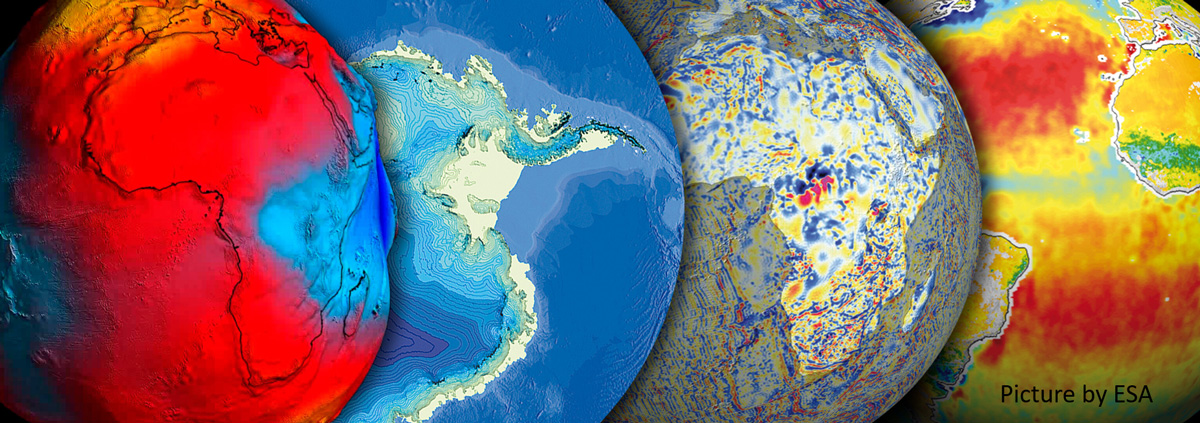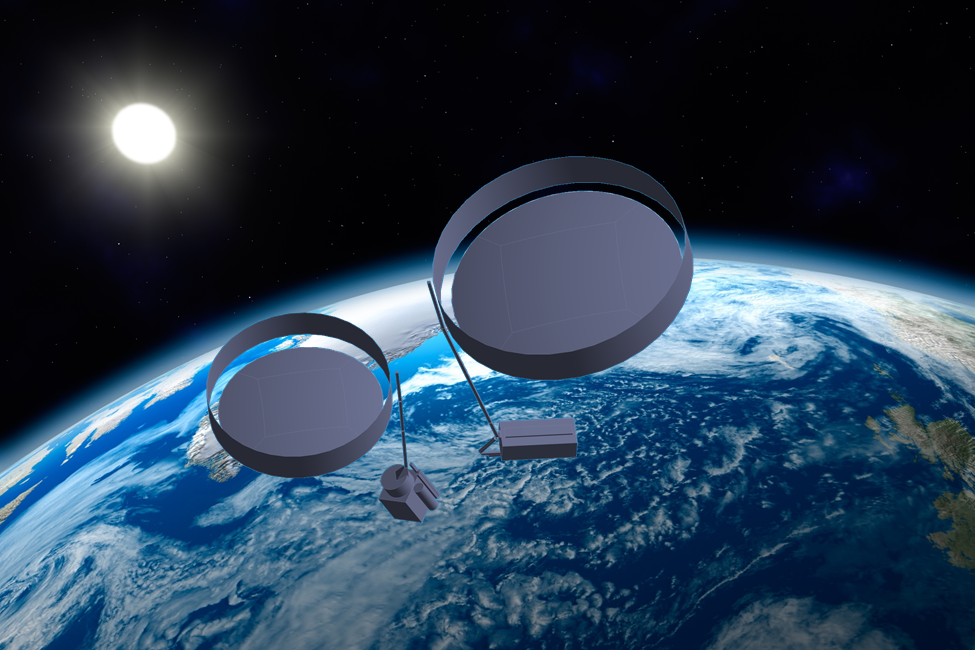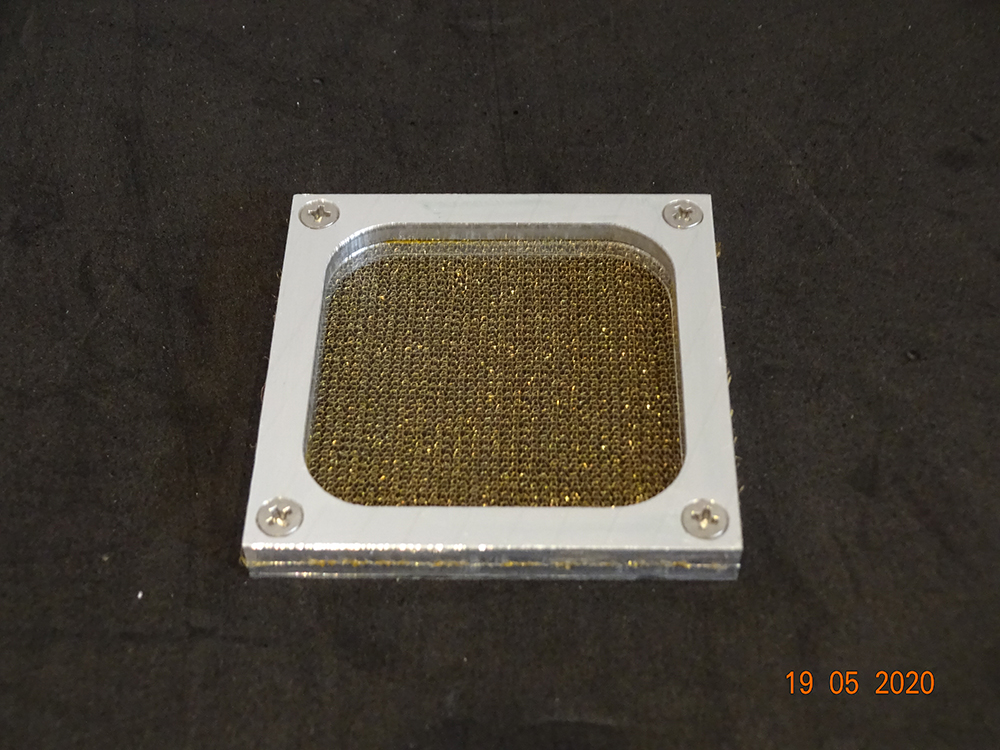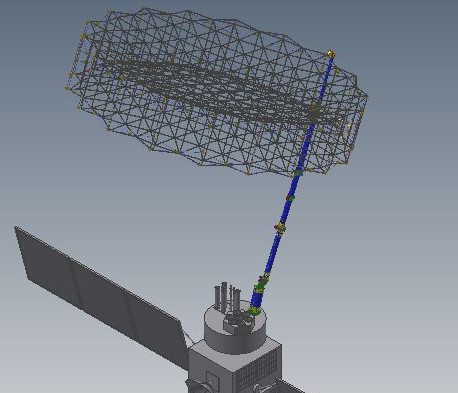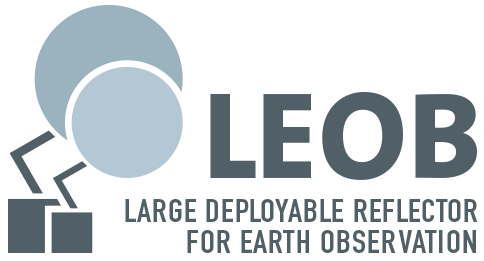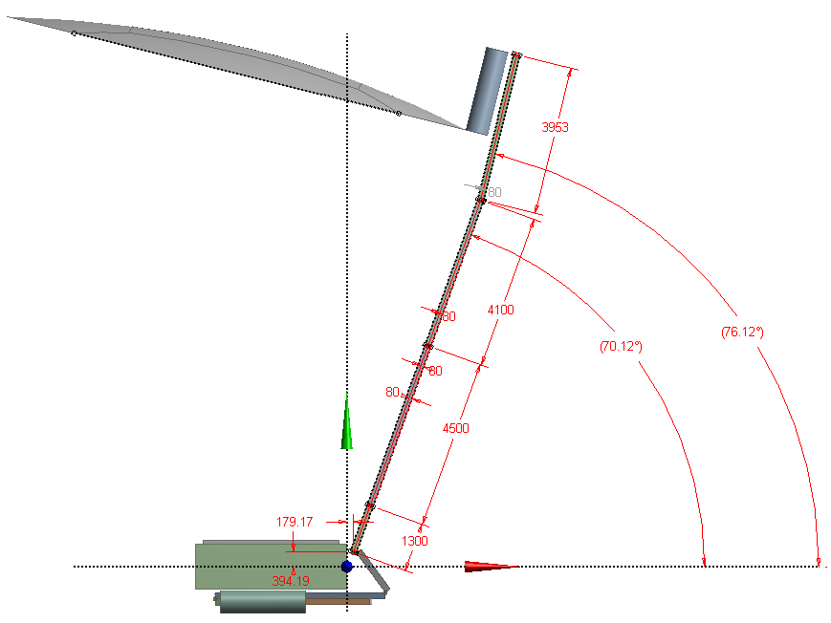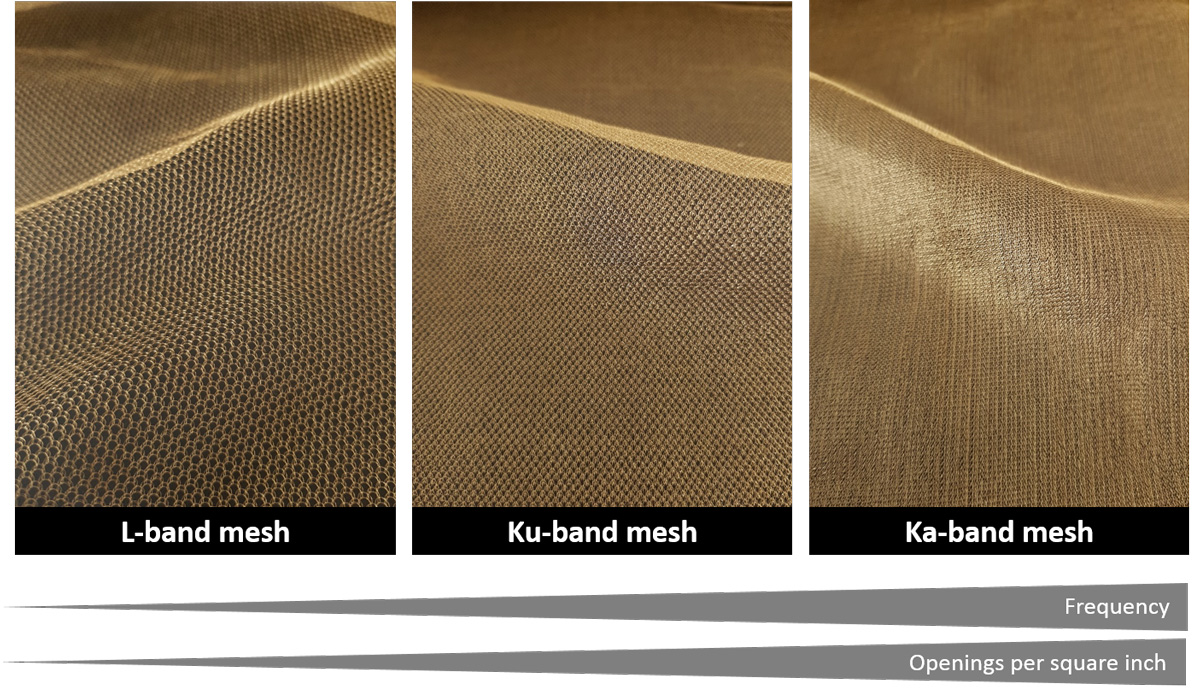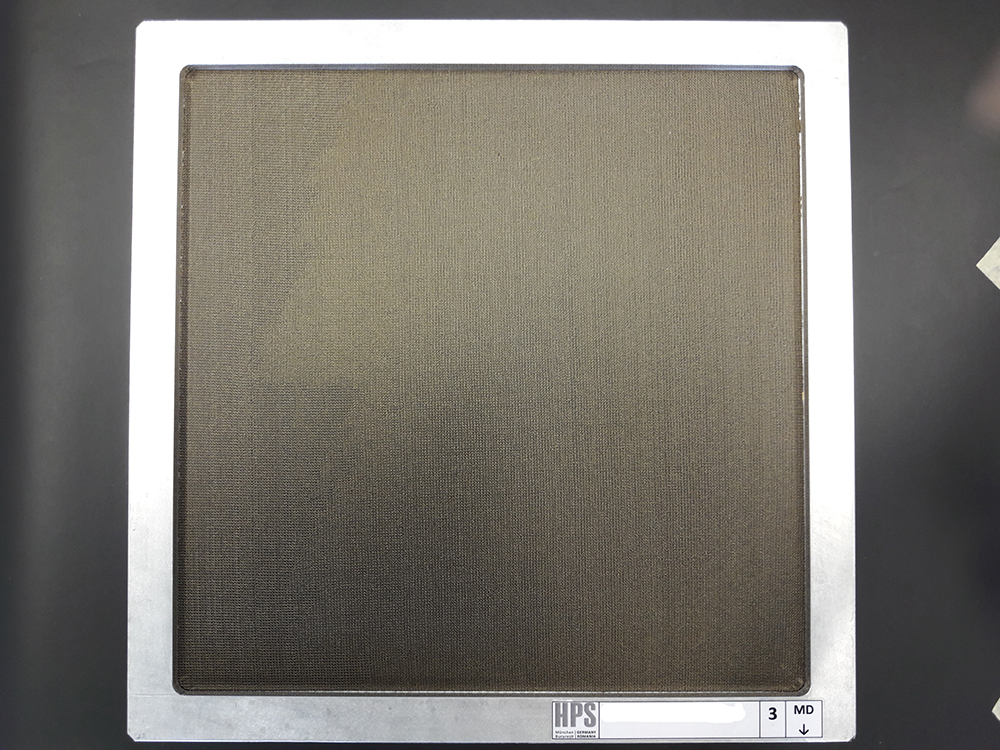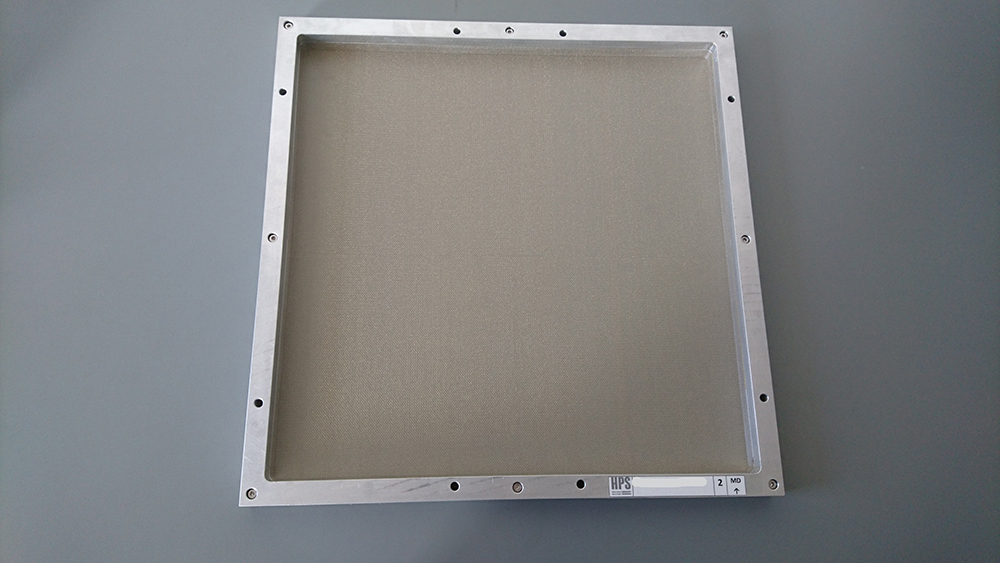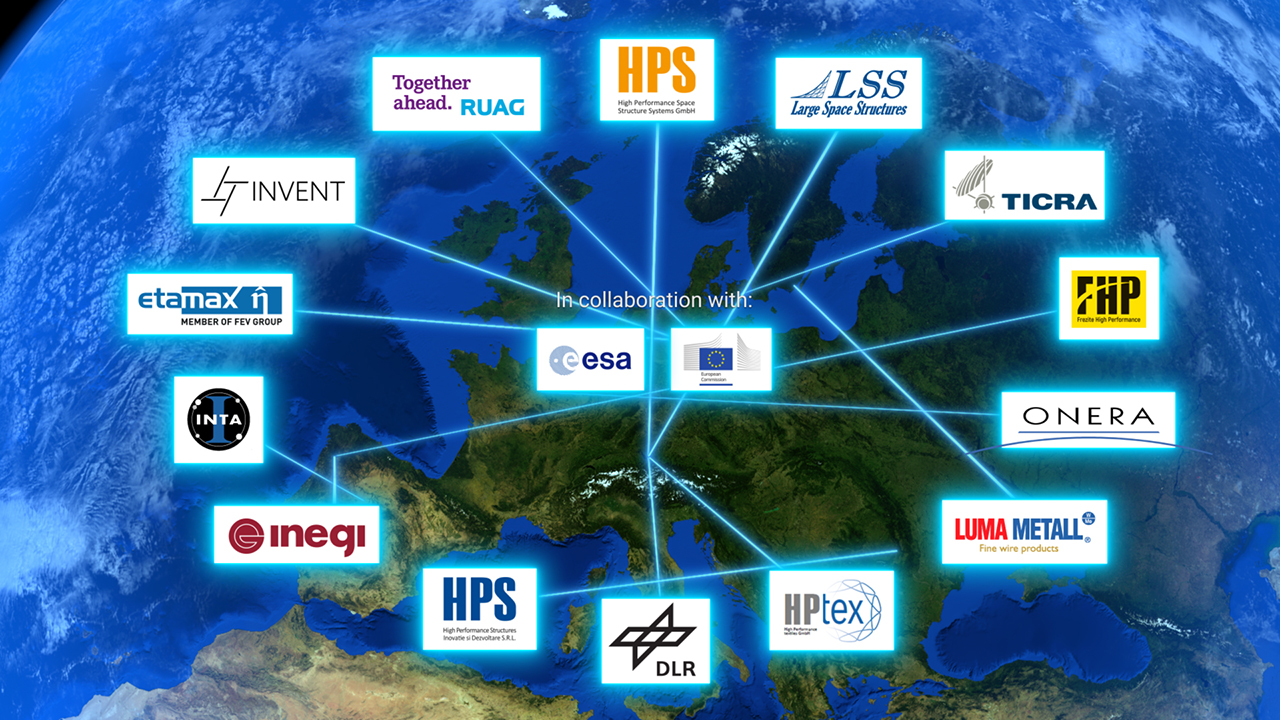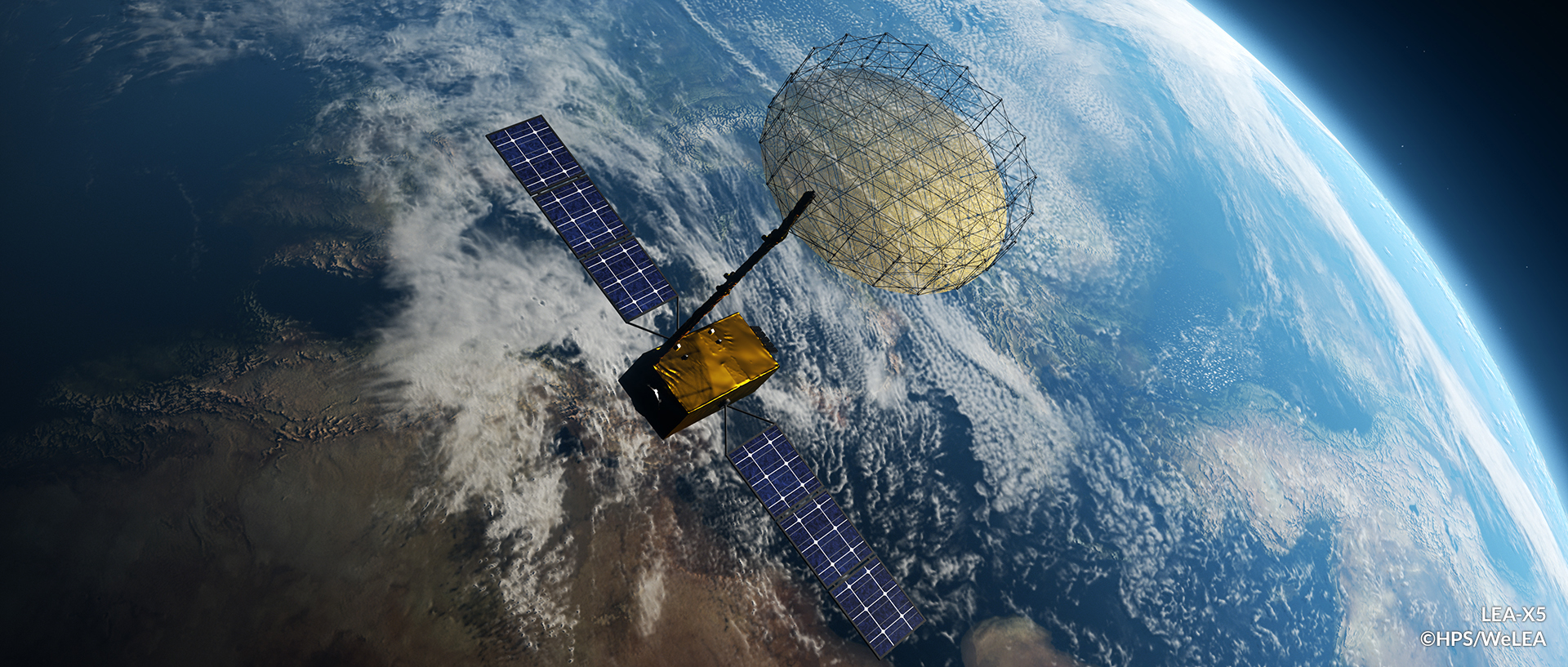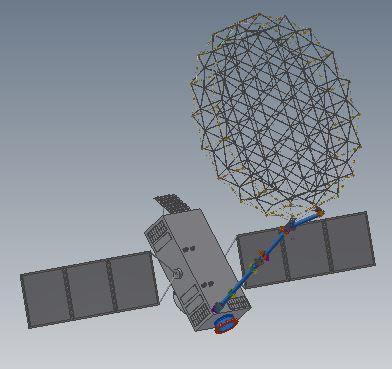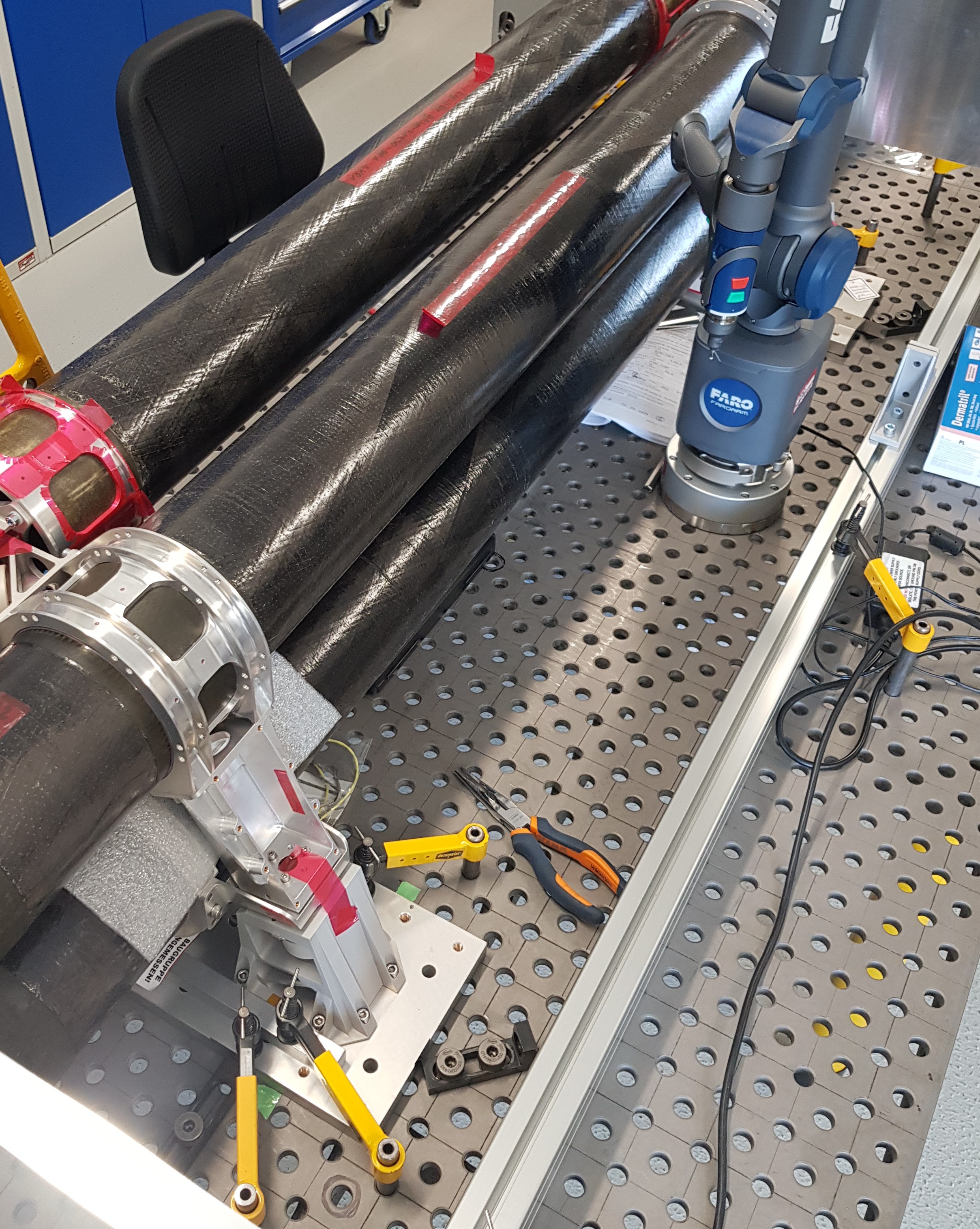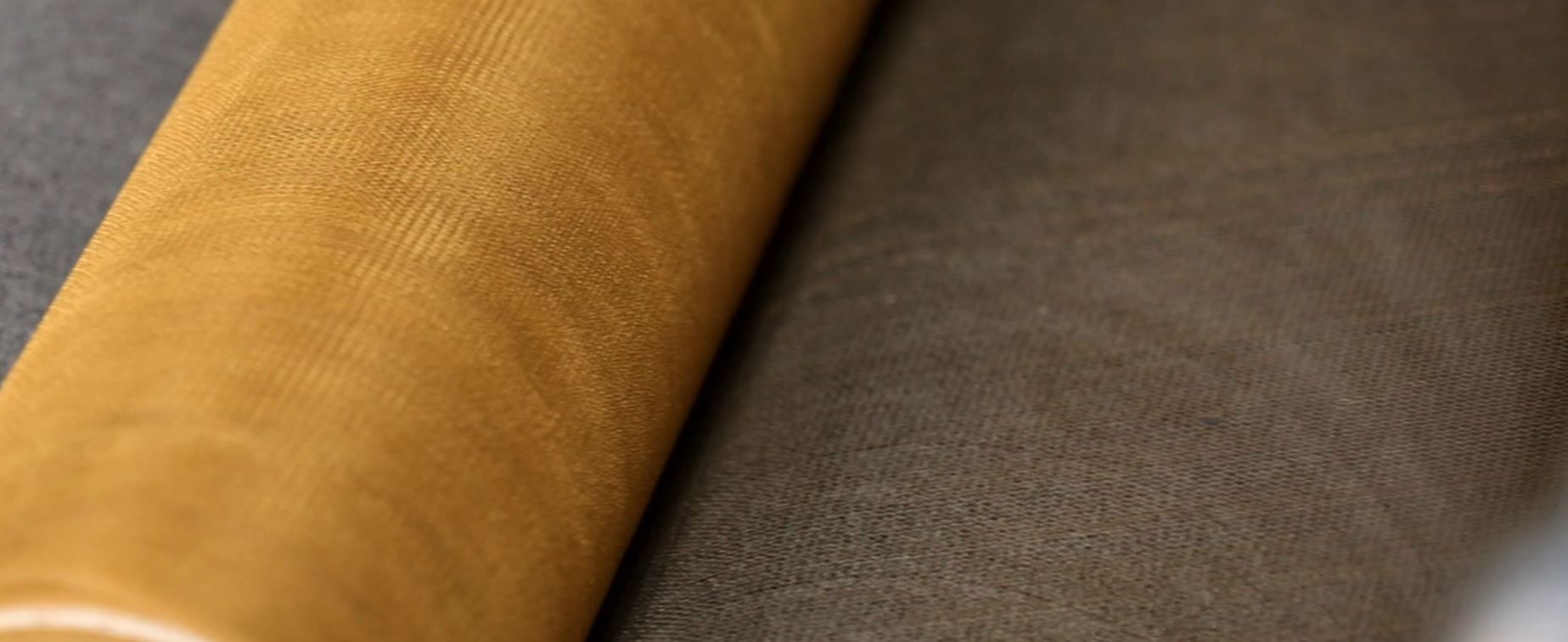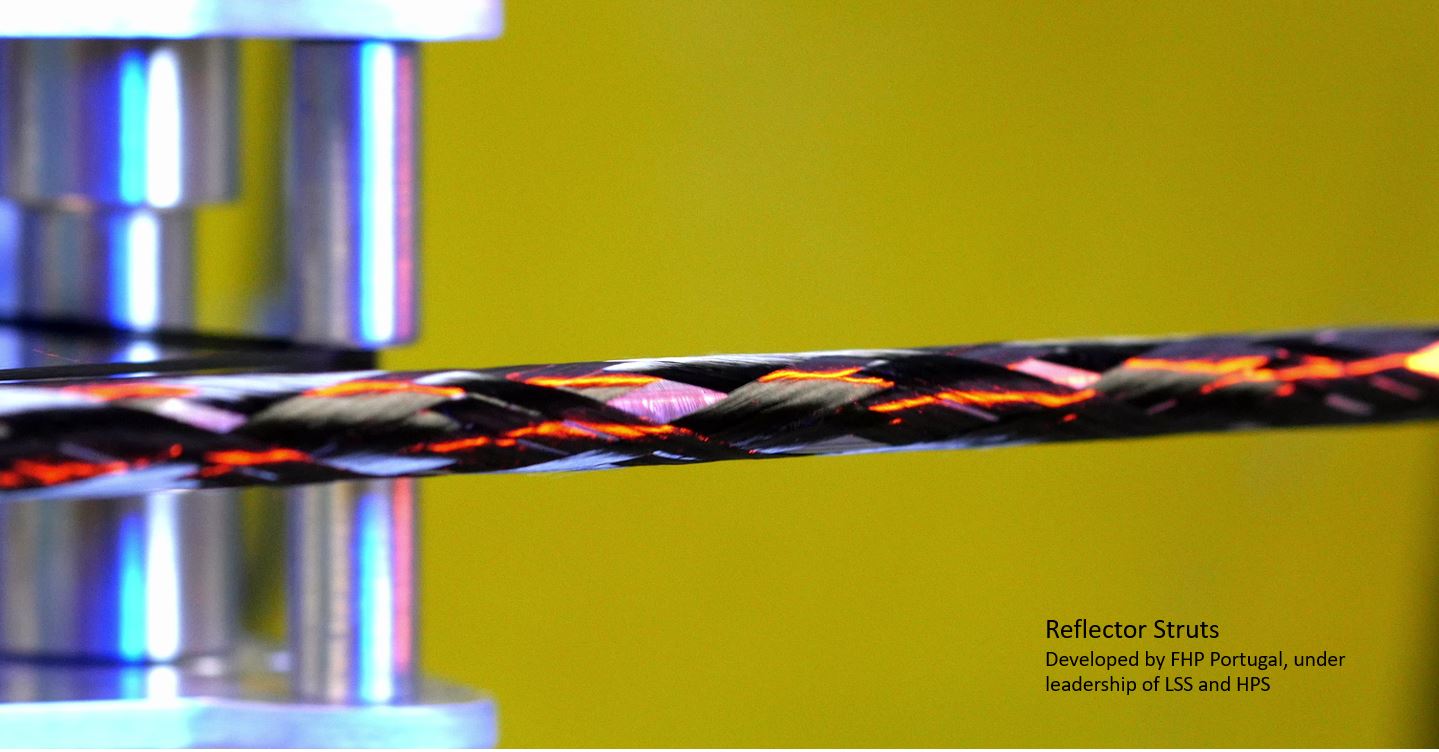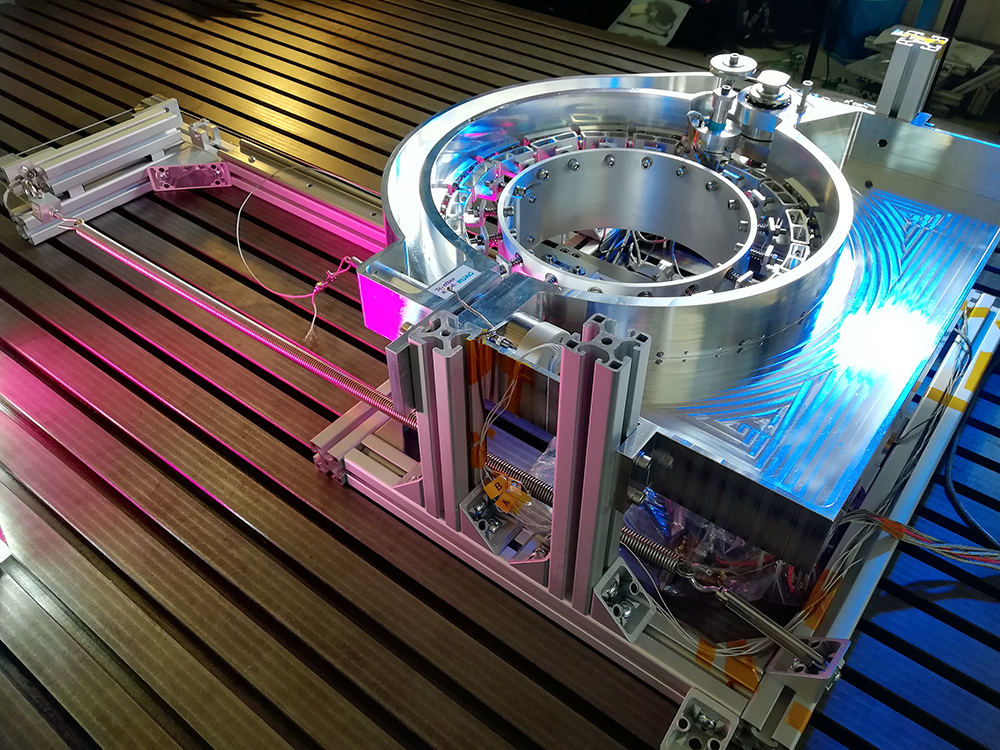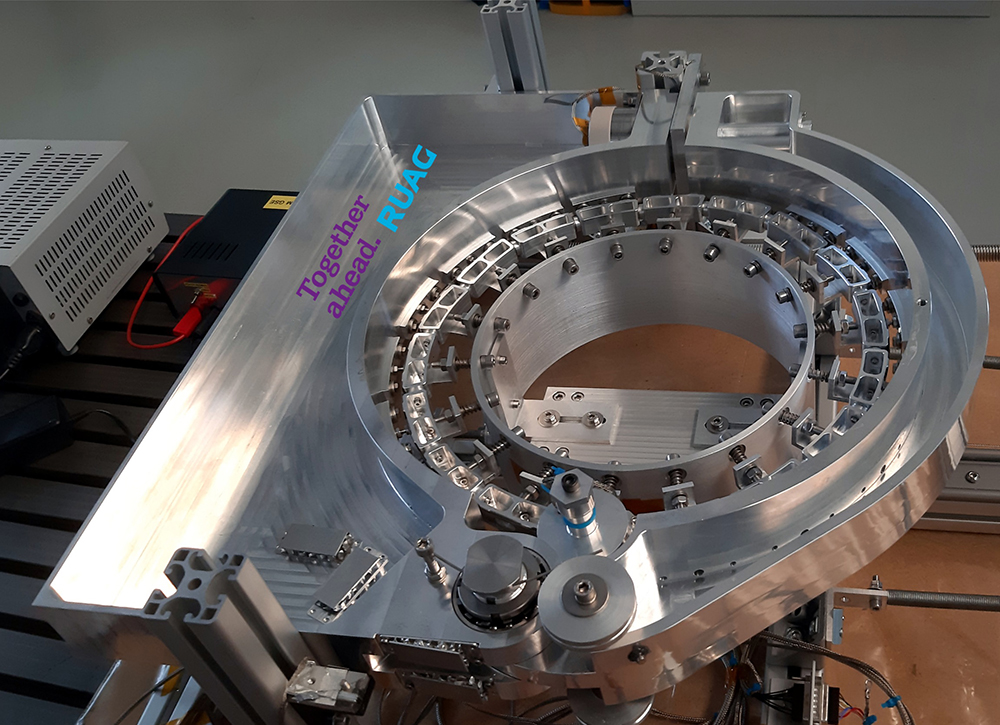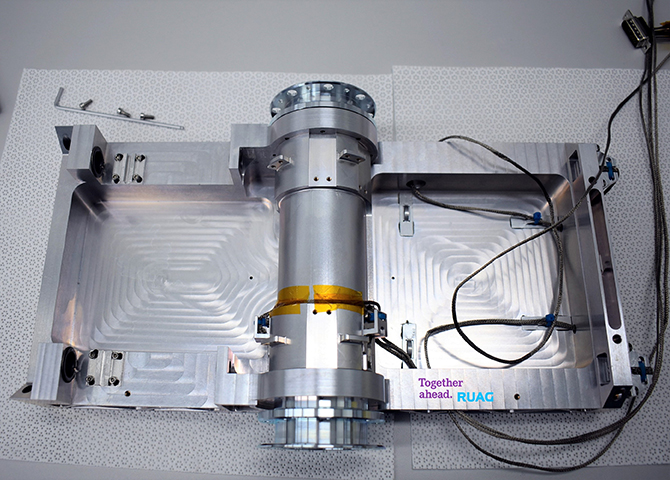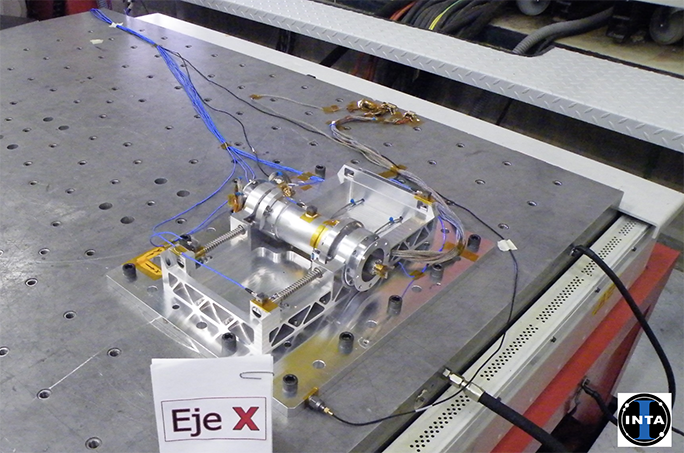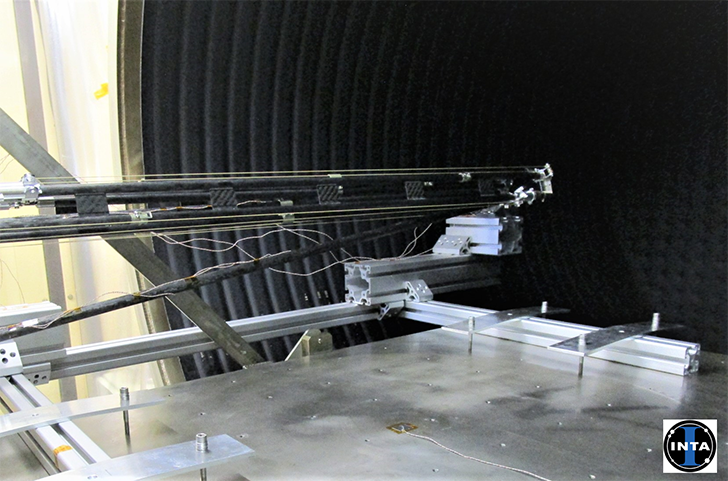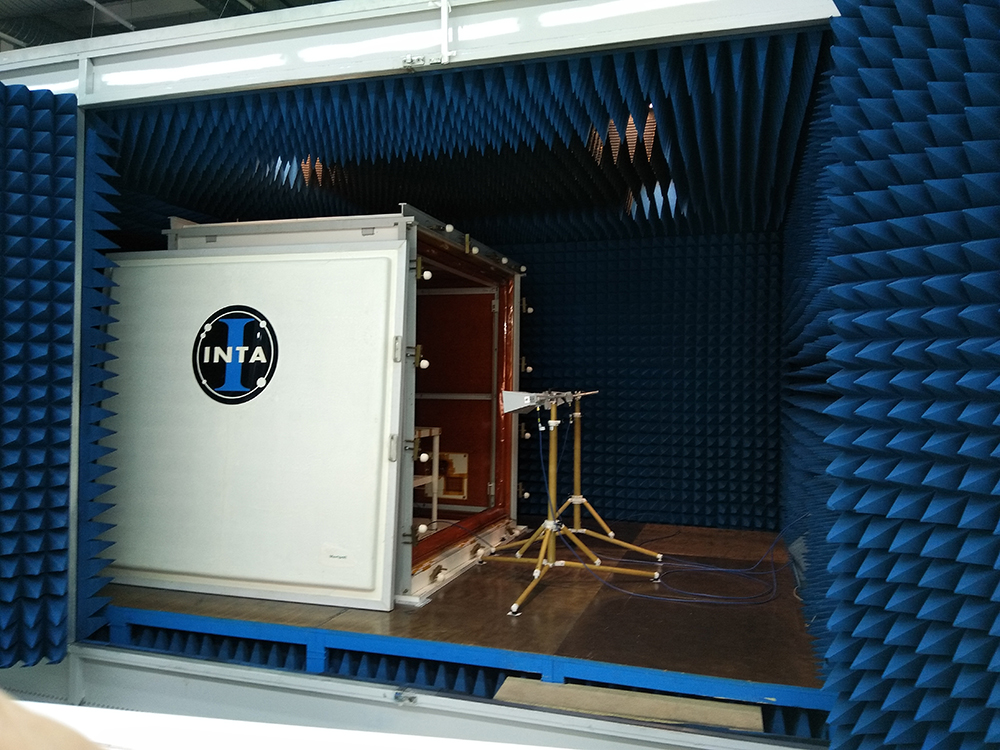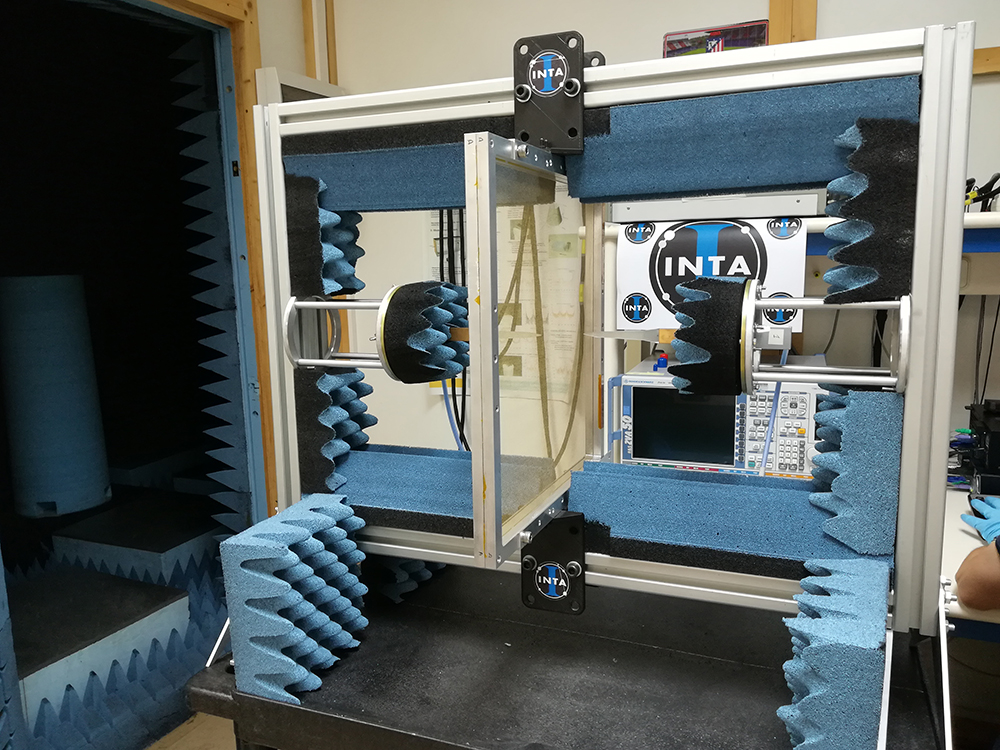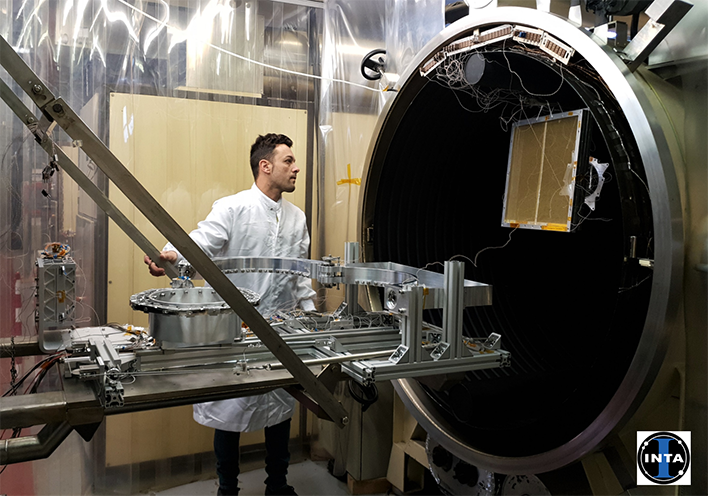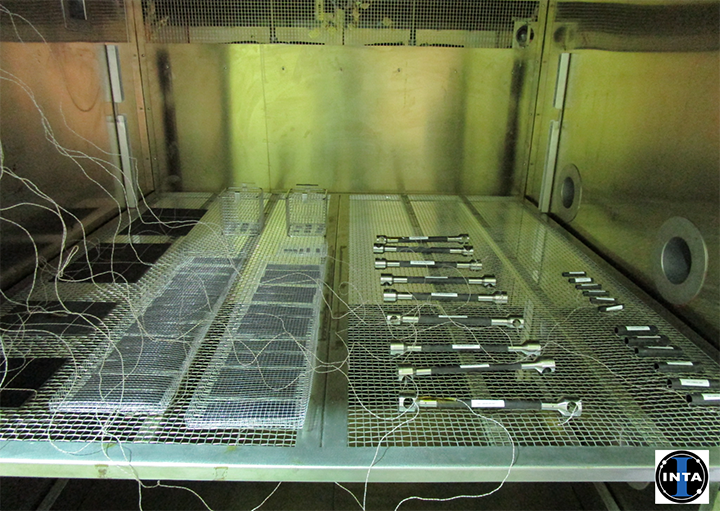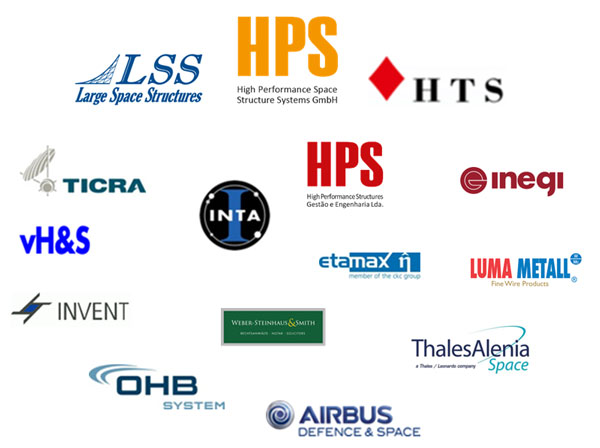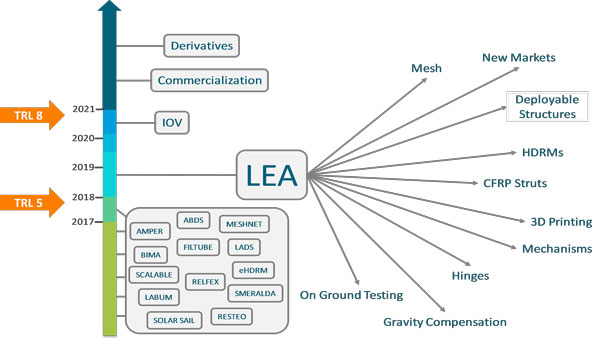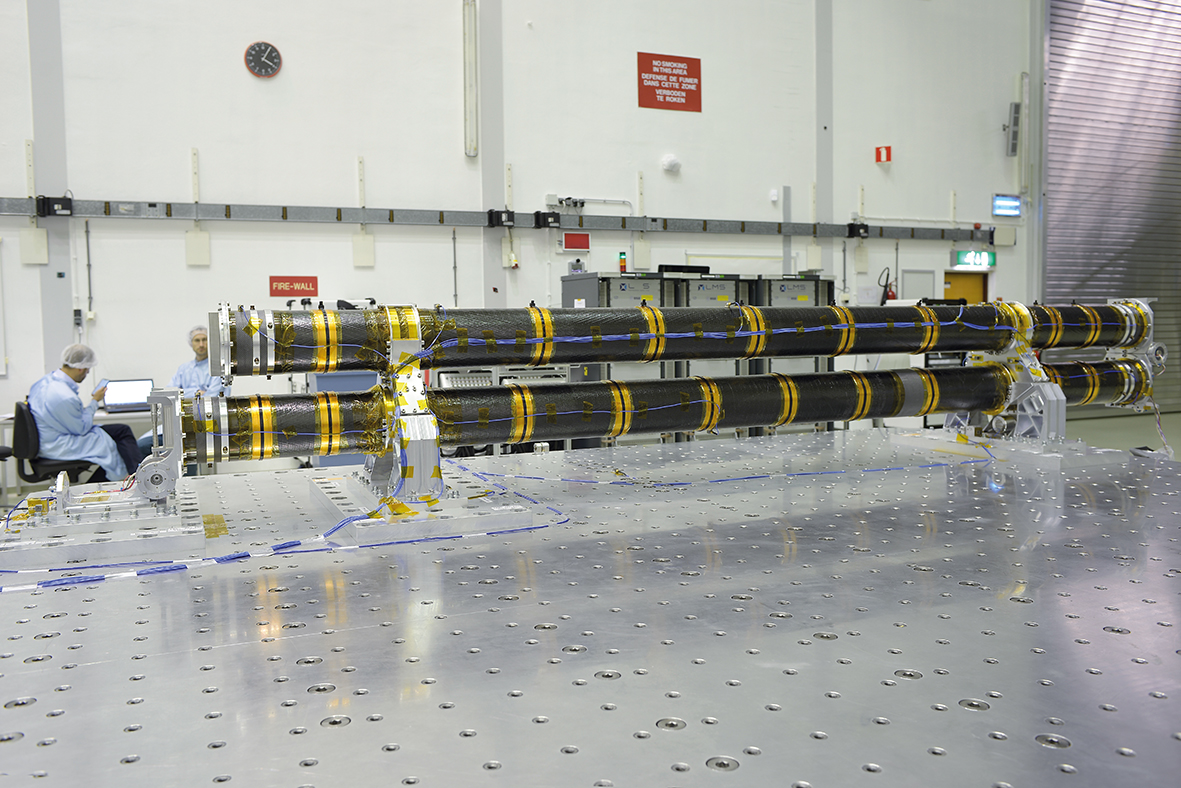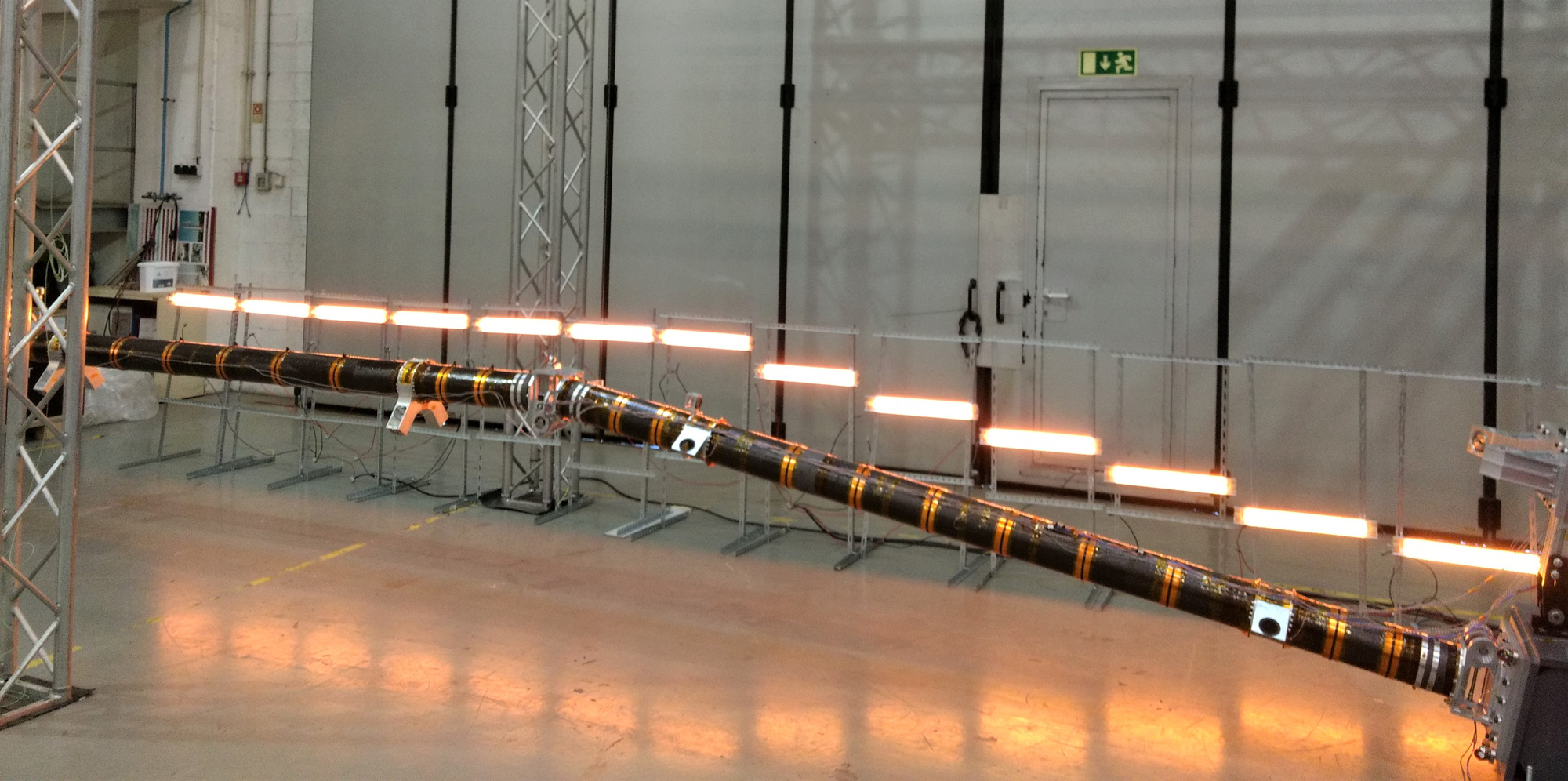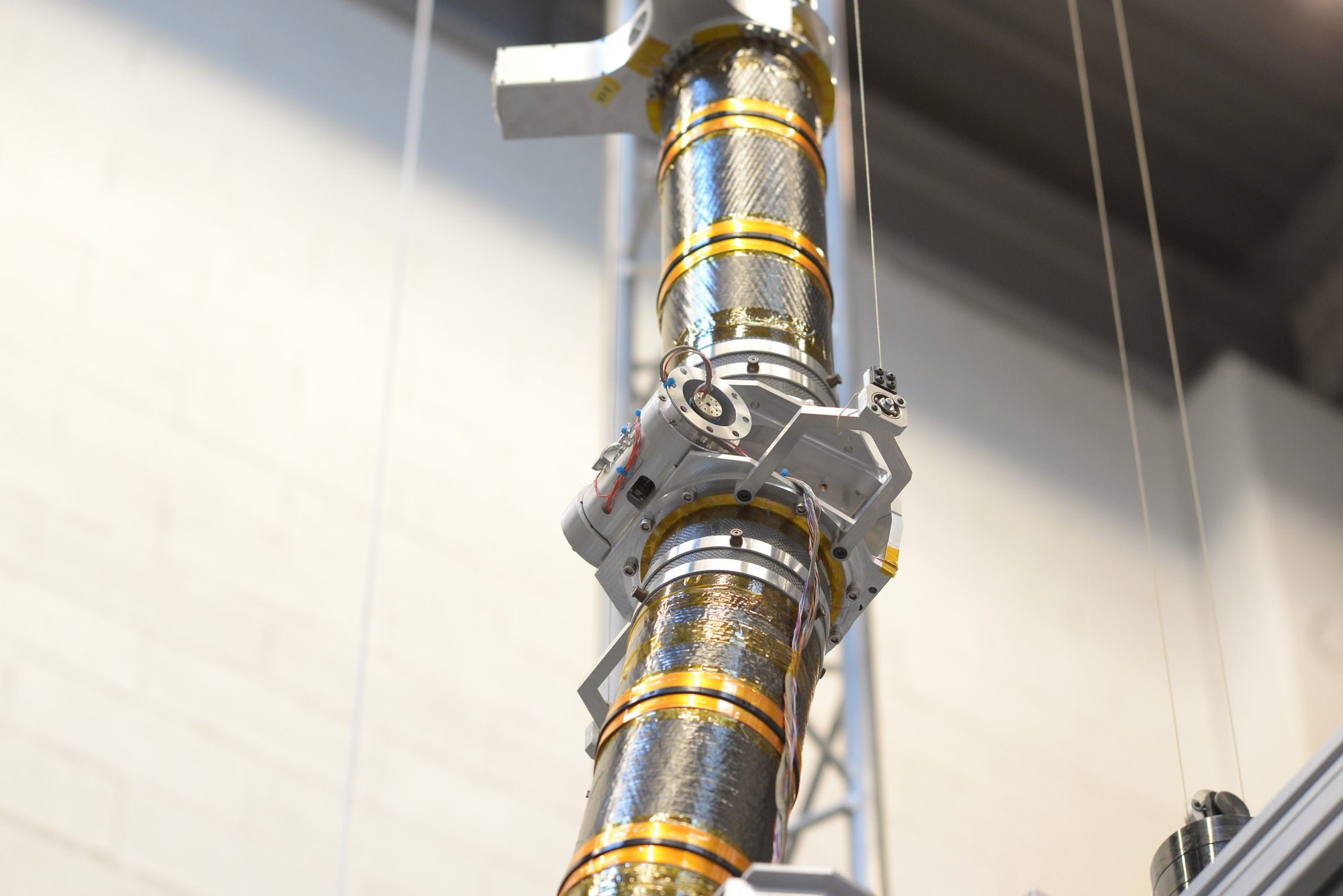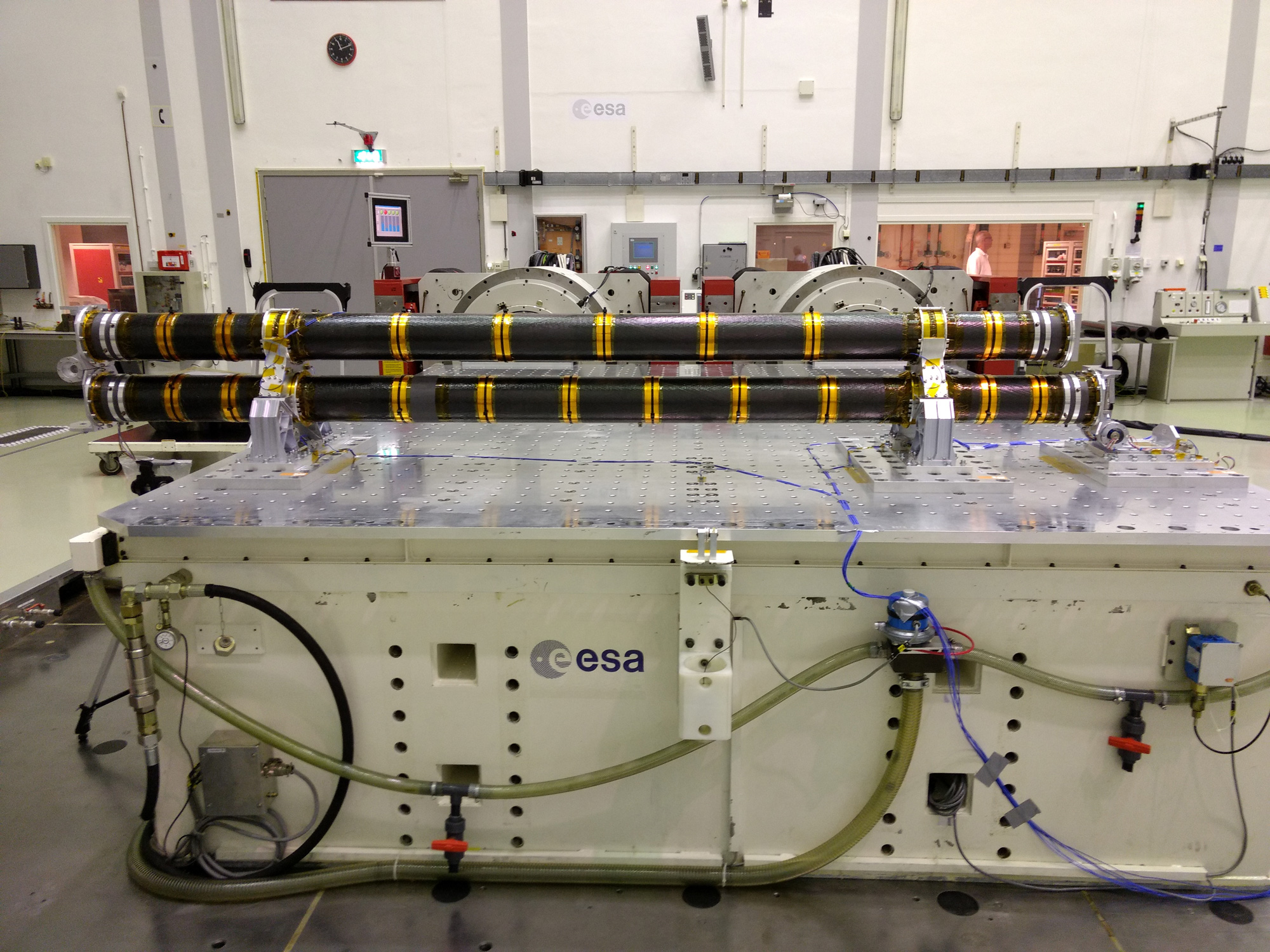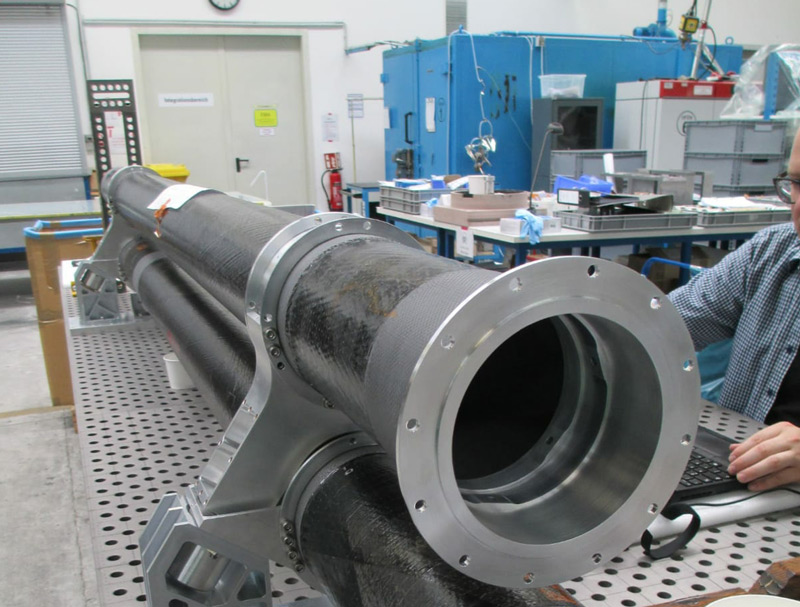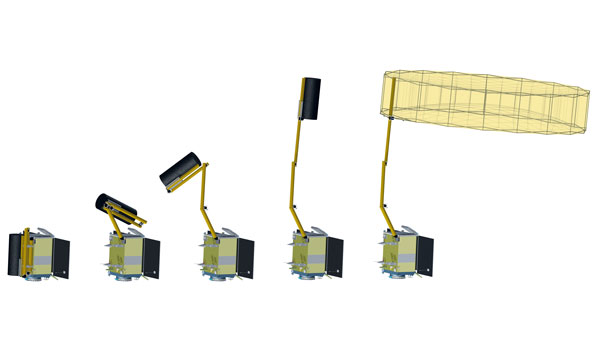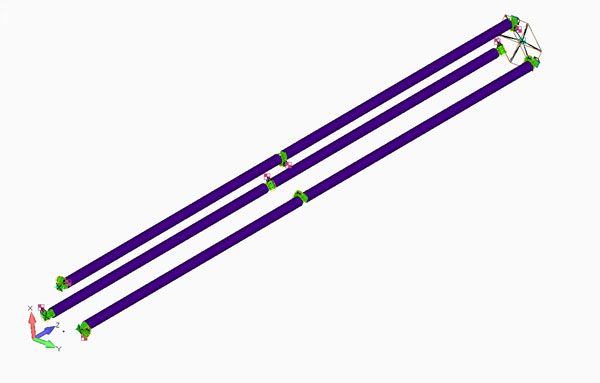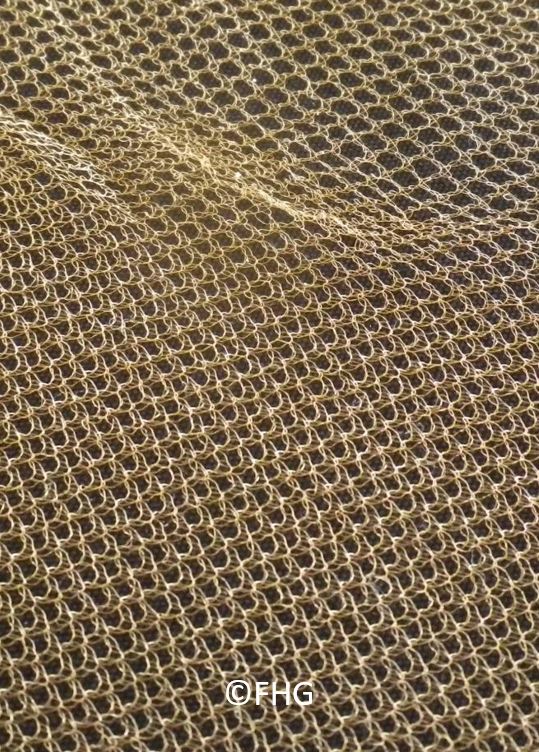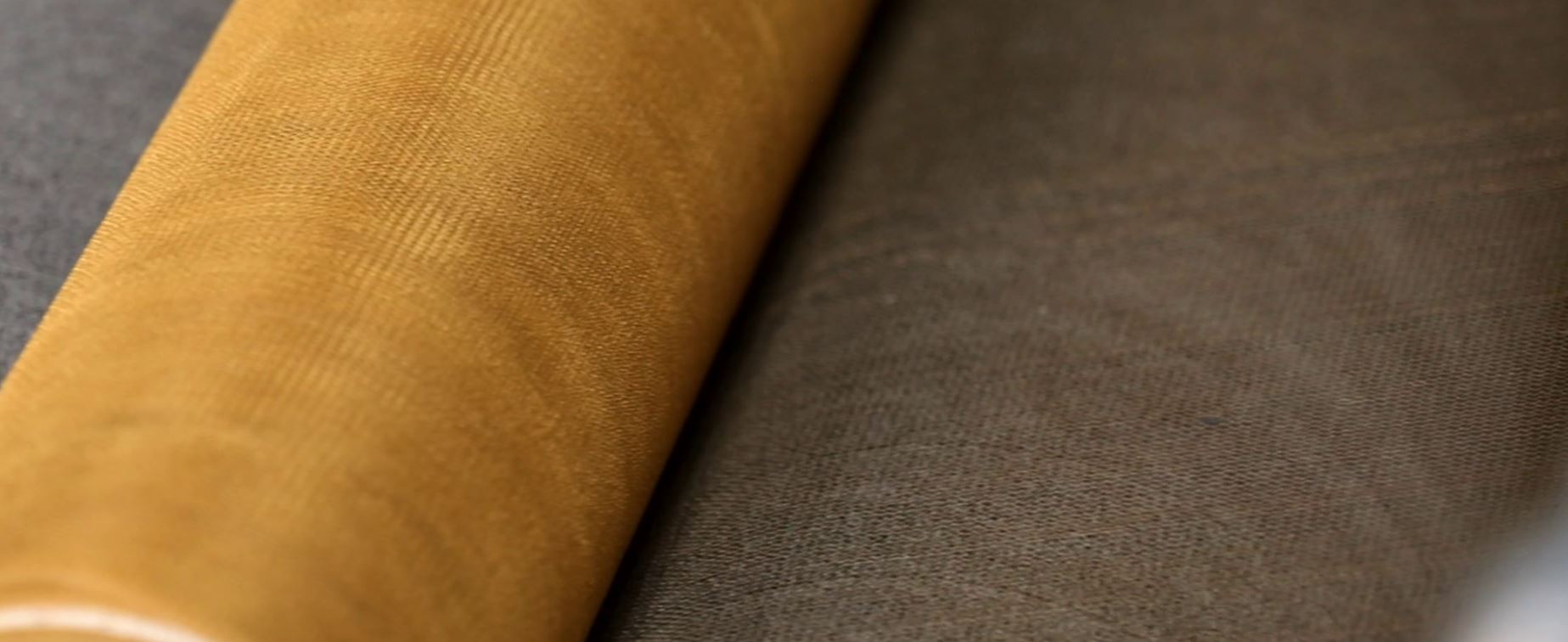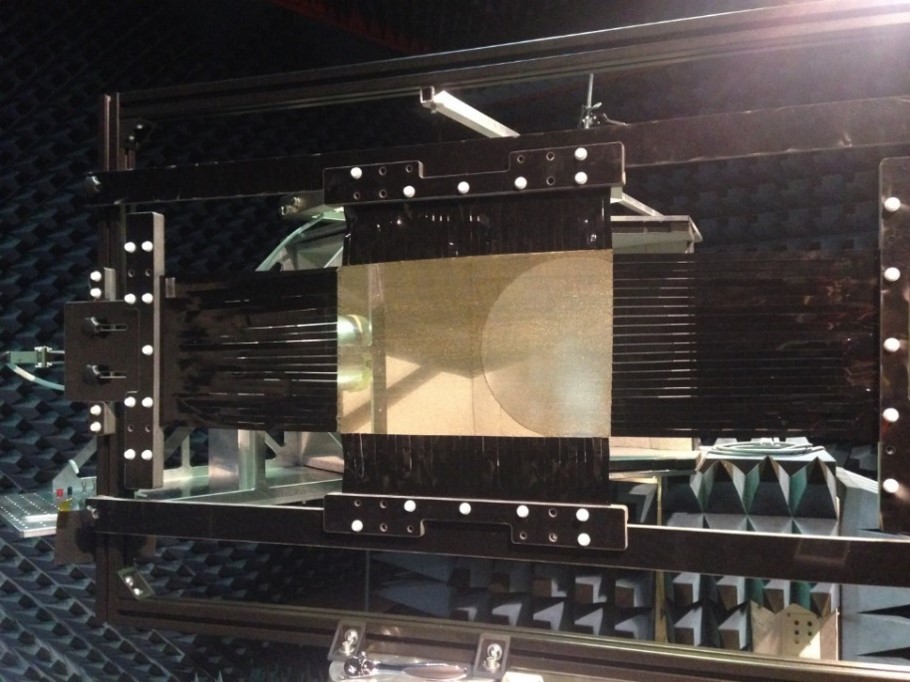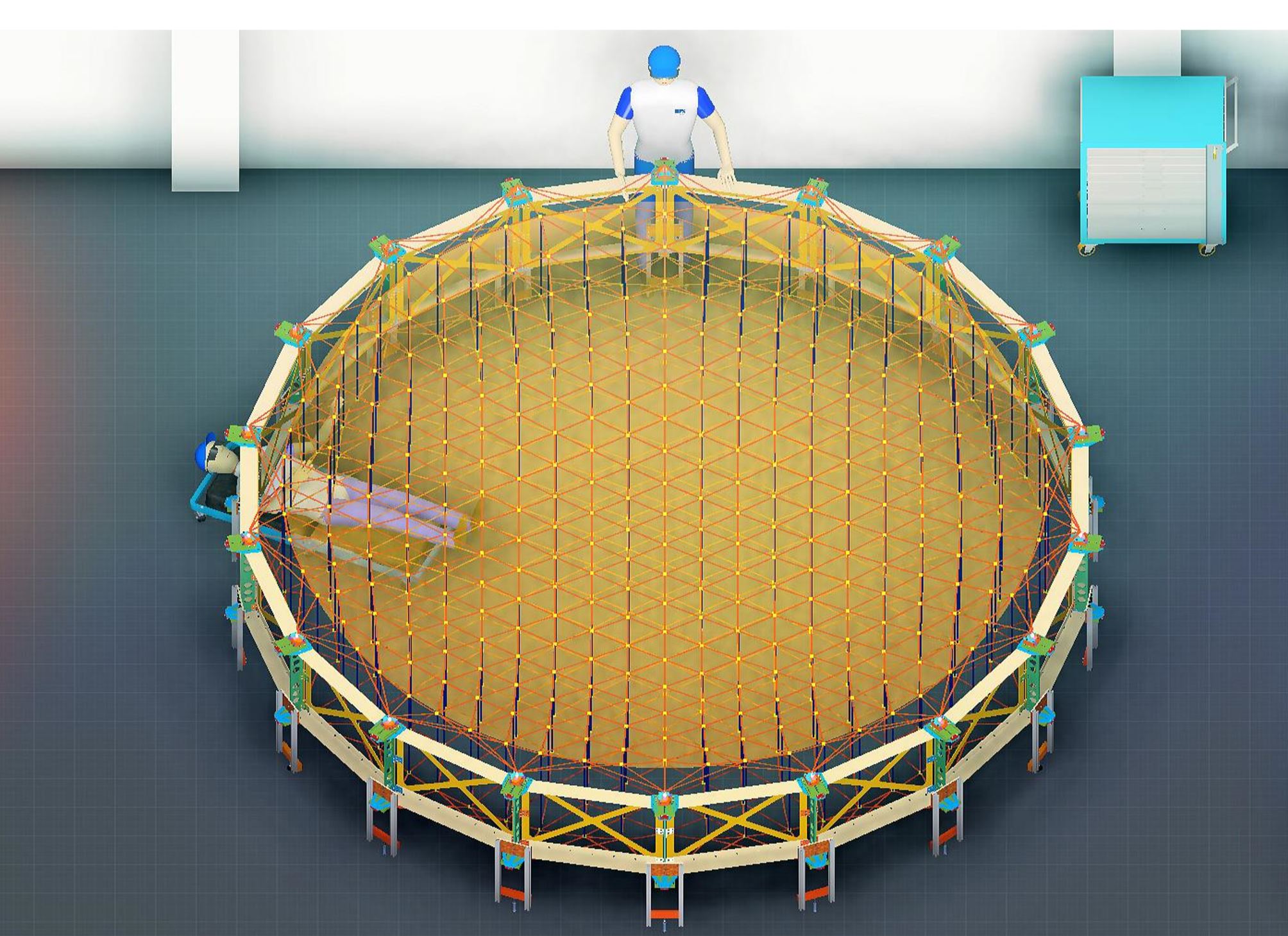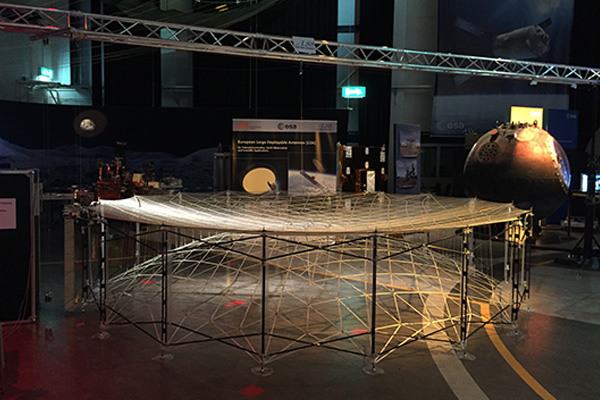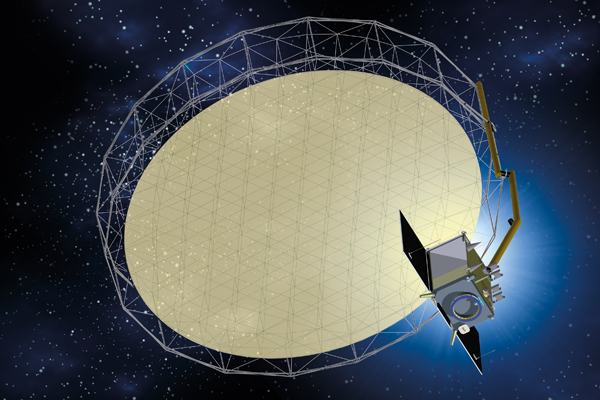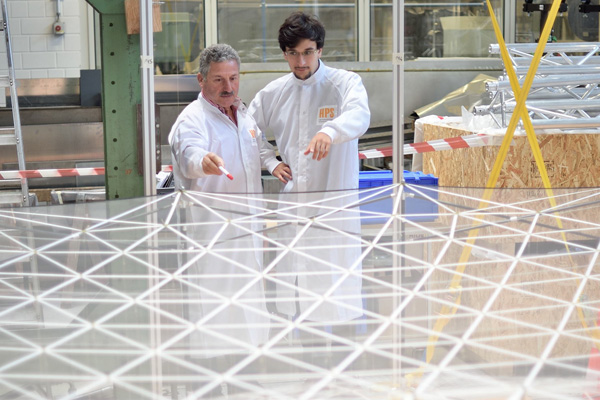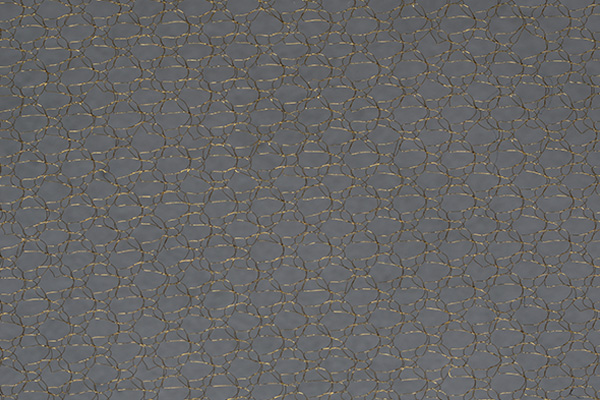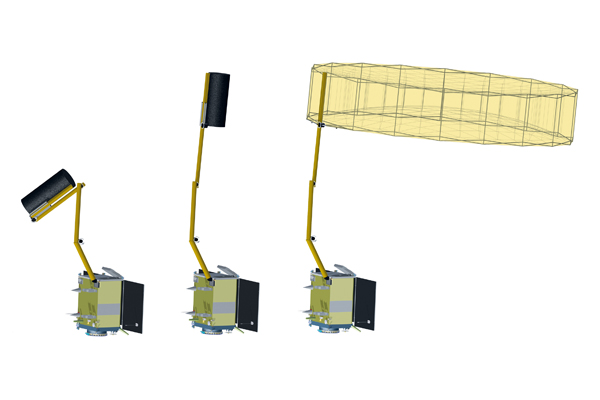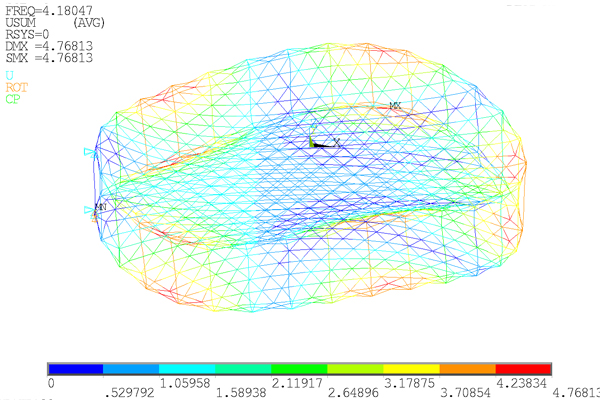Große Entfaltbare Reflektorsubsysteme
Die zunehmende Komplexität weltraumbasierter Anwendungen im Zivil- wie Militärbereich verlangt in Zukunft nach großen entfaltbaren Antennen, zudem gleichzeitig die Forderung nach geringeren Transportkosten unausweichlich auch kleinere Pack-Einheiten bedingt. Für eine Reihe von Anwendungen liegt der strategische Schlüssel zur technologischen Lösung in „großen entfaltbaren Reflektor-Subsystemen (LDRS)“.
Auf der Ebene der Subsysteme hat die bayerische HPS GmbH schon sehr früh ihren Führungsanspruch auf dem Gebiet entfaltbarer Reflektor-Subsysteme mit Fokus auf Skalierbarkeit, Modularität, Staufläche, Masse und – nicht zuletzt – Preis angemeldet. Das Angebot von HPS, in enger Zusammenarbeit mit der Münchner Firma LSS, deckt alle Anwendungsfelder von LDRS ab, sei es Erdbeobachtung, Telekommunikation, Wissenschaft oder Verteidigung. Sie umfassen komplette Subsysteme mit Reflektoren, Arms/Booms, Hinges, HDRMs, thermale Hardware, Kabelbaum, Elektronik für eine kontrollierte Entfaltung, EGSE und Entfaltungs-MGSE.
HPS agiert als Hauptauftragnehmer für die LDRS Projekte und ist verantwortlich für sämtliche Subsystemkonfigurationen, Design & Analysis, das Design für den RF Reflektor, das reflektive Metallnetz, der entfaltbare Arm, sowie die LDRS Integration und die Tests. Darüber hinaus bildet die äußerst enge Kooperation mit mehr als 15 erfahrenen europäischen Unternehmen (die meisten sind KMUs), vor allem mit der deutschen Firma LSS (Reflektorzusammenbau), Beyond Gravity Germany (früher RUAG Space Germany) (HDRM/Hinge) und von Hoerner & Sulger (Elektronik, Harness, EGSE) eine solide Grundlage der Führungsposition.
Inzwischen ist das starke Konsortium, namens „WeLEA“, mit ihrem Produkt „LEA“ die zuverlässige und zukunftsfähige europäische Quelle für LDRS:
- LEA-C5 (5m Durchmesser, C-band): Das Reflektor-EM wurde erfolgreich beim Entfalten 2016 getestet.
- LEA-X5 (5m Durchmesser, X-band Anwendung): Das komplette PRM-Subsystem ist produziert und wird getestet im zweiten Halbjahr 2020.
- LEA-L12 (12m Durchmesser, L-band): Das komplette Subsystem wurde konstruiert in 2019.
- LEA-K8r (8m Durchmesser, L- bis Ka-band, rotierend): Das komplette Subsystem wurde konstruiert in 2019. Das Reflektor-EM samt oberstem Arm Segment wird die Tests in Q1/2021 abschließen. Das Team wurde von Thales Alenia Space Italien und der ESA ausgewählt als Baseline für die Phase B2/C/D der Copernicus Mission CIMR, mit Kick-off in Q3/2020.
- LEA-C7+ (7-10m Durchmesser, C-band): Das komplette Subsystem befindet sich in einer Phase 0 Studie. Das komplette Subsystem befindet sich in einer Phae 0/A Studie für die ESA Mission Hydroterra.
Kontakt:
Bei Fragen wenden Sie sich bitte an unseren leitenden Ingenieur.
Oder direkt an: LDRS@hps-gmbh.com
Referenzprojekte:
→ Success Trajectory
CIMR LDRS Phase B2/C/D/FM2 (EQM, PFM, FM2)
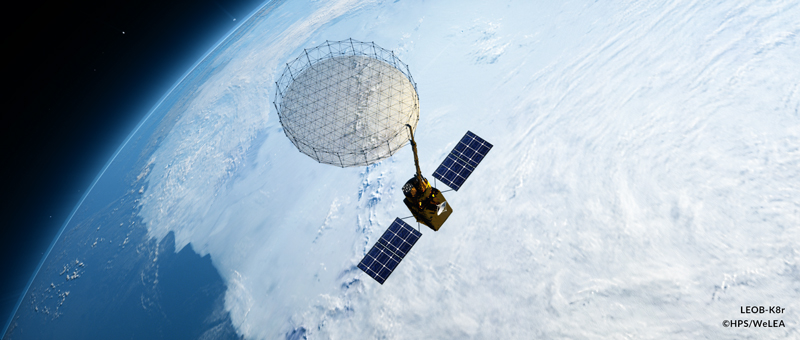
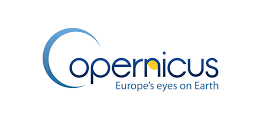
Description
- CIMR-mission provides significant contribution to „Integrated European Policy for the Arctic“:
- Improved continuity (sub-daily) in monitoring of floating sea ice (spatial and temporal resolution)
- Global coverage of sea surface temperature measurements
- Specific focus on the Polar Regions
- Two satellites (PFM + FM2) are contracted to ThalesAleniaSpace Italy under ESA/EC’s Copernicus Program
- HPS GmbH, Munich, Germany, has been contracted by the satellite prime for the development, manufacturing and testing of the Large Deployable Reflector Subsystem (LDRS)
- LSS GmbH, Munich, Germany, is main partner and is contracted by HPS for the Deployable Reflector Assembly (DRA)
- In total, more than 15 companies (mainly SME) out of 7 European countries are part of the HPS-team, called “WeLEA”.
- 12/2020: Contract signature
- 2022: PDR
- 2027: Launch of PFM satellite.
CIMR-LDRS Features:
- 8 m reflector diameter
- 8 m arm length
- L- up to Ka-Band application
- Rotating Subsystem, comprising:
- Deployable reflector assembly
- Deployable arm assembly
- HDRM
- Electronics
- Harness
- Thermal Hardware
- MGSE & EGSE
Phase B2 Objectives:
- Definition of interfaces to satellite
- Detailed design of the LDRS-EQM
- Intensive breadboard test program
- Development and production of Ka-band mesh by the HPS/IPROTEX joint-venture “HPtex” (with cooperation from Frauenhofer ISC)
- Demonstration of Technology Readiness Level 5 within 6 months and TRL 6 at PDR.
Hydroterra-LDRS Phase 0/A
- Phase 0/A under ESA´s Earth Explorer Program (EE-10)
- Objectives:
- Risk Retirement Activities for System Study
- Concept for the LDRS
- Accommodation assessments on satellite platforms
- Performance and budget predictions
- Development Planning.
- Customer: Airbus (UK/DE), Thales Alenia Space (IT)
- LDRS-Prime: HPS-Germany with LSS as subcontractor
- Timeframe: 02/2020 – 09/2020.
CIMR-/ROSE-L-LDRS Phase A/B1
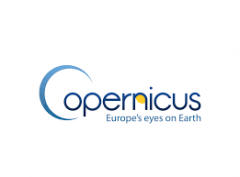
- Phase A/B1 under ESA/EC’s Copernicus Program
- Objectives:
- Design concept for the LDRS
- Accommodation assessments on satellite platforms
- Performance and budget predictions
- Development Planning
- Ka-band mesh pre-development.
- Customers:
- Airbus (UK/ES/DE) for CIMR & ROSE-L & Mesh Pre-development
- ThalesAleniaSpace/OHB (IT) for CIMR & Mesh Thermal Samples.
- LDRS-Prime: HPS-Germany
- Subcontractors: LSS and further WeLEA-partners
- Timeframe: 05/2018 – 09/2020
Entfaltbarer Reflektor für EO (LEOB)
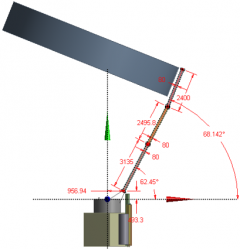
Description:
- Development project under ESA’s Earth Observation Program / Copernicus
- Applications:
- Copernicus Mission CIMR (fresh data every day on the pattern of sea ice variability in the polar regions)
- Copernicus Mission ROSE-L (tracking of biomass changes and mapping of life and woodland, distribution of vegetation and soil humidity)
- Objectives:
- Design and analysis of Large Deployable Reflector Subsystems (LDRS) for CIMR and ROSE-L
- Critical breadboarding (reflector struts, bay segments, L- and Ka-band mesh)
- Realization of an Engineering Model (“LEA-K8r EM”) for CIMR application
- EM includes deployable reflector assembly plus upper arm segment, HDRM, electronics, GSE
- Large test campaign (deployment, surface accuracy, thermal, vibration, RF)
- Longterm development planning
- Budget: 5 Mio Euro in contract to ESA
- Timeframe: 4/2019 – 04/2021
- Start TRL: 5, End TRL: 6
References:
Youtube-LEA-Movie
Team (“WeLEA”):
- 17 development partners (DE, RO, PT, ES, DK, SE, FR)
- Lead: HPS-Germany (project & technical management)
- Main subcontractor: LSS (deployable reflector assembly)
- Further subcontractors: RUAG, TICRA, FHP, vH&S, INVENT, HPTEX, LUMA, ARQUIMEA, ETAMAX, INEGI, HPS-RO, INTA, AIRBUS, DLR, ONERA, WSS.
Features:
- LEA-K8r EM (LEOB-EM) includes: reflector, deployment mechanisms, metal mesh, upper arm segment, upper hinge, reflector hold-down-and-release-mechanisms, thermal hardware, harness, deployment control electronics, deployment test-MGSE & -EGSE, RF test-GSE.
- LEA-K8r specification:
- 7.4 m reflective aperture diameter
- 9.1 m ring diameter (max.)
- 8.3 m arm length
- F/D = 0.9
- Rotation speed: 8 rpm
- L-band (1.3 GHz) to Ka-band (37 GHz)
- Subsystem total onboard mass: 167 kg
- Deployed total mass: 114 kg.
- LEA-L12 specification:
- 12 m reflective aperture diameter
- 14.6m ring diameter (max.)
- 12.8m arm length
- F/D =0.875
- L-band(1.215-1.3 GHz)
- Subsystem total onboard mass: 235kg
- LEA-products in general are scalable:
- 3 m to 25 m reflector diameter
- 1 m to 20 m arm lenght
- RF frequencies: C-, L-, S-, P-, Ku-, Ka-Band.
Highlights:
- 15.04.2019: Kick-off
- 10.07.2019: Breadboard TRR & selection of CIMR reflector configuration for EM
- 12.12.2019: Detailed Design Review
- Sept. 2020 (tbc): Test Readiness Review
- Dec. 2020 (tbc): Completion of 1st deployment& accuracy test
- April 2021 (tbc): Delivery and Contract Close-out.
Entfaltbarer Arm für EO (LADEA)
Description:
- Development project under ESA’s Earth Observation Program
- Objectives:
- Realization of an Engineering Model of a deployable arm assembly
- 8m length for CIMR application (rotation of the LDRS on top of satellite, Ka-band)
- Large test campaign (deployment, surface accuracy, thermal, vibration)
- Budget: 0.5 Mio Euro in contract to ESA
- Timeframe: 1/2020 – 01/2021
- Start TRL: 5, End TRL: 6
Team (“WeLEA”):
- 9 development partners (DE, RO, ES, PT)
- Lead: HPS-Germany (project & technical management)
- Subcontractors: INVENT, RUAG, FHP, vH&S, LSS, INEGI, HPS-RO, INTA.
Features:
- LEA-K8r Arm EM (LADEA-EM) includes: two arm segments, arm hinges, MLI deployment control electronics EGSE, deployment test-GSE.
- LEA-K8r Arm specification (in full configuration):
- 3 arm segments, 2 hinges
- 9.7 m arm length
- Rotation speed: 8 rpm
- Arm tip accuracy (with mounted reflector and under rotation): < 1.4 mm
- Arm tip thermo-elastic stability: +/- 0.5 mm
- Deployed total mass: 51 kg (including subsystem harness).
Highlights:
- 20.01.2020: Kick-off
- 26.03.2020: Preliminary Design Review
- June 2020 (tbc): Manufacturing Readiness Review
- Aug. 2020 (tbc): Test Readiness Review
- Oct. 2020 (tbc): Test Review Board
- Jan. 2021 (tbc): Delivery and Contract Close-out
Große Europäische Antenne (H2020 LEA)
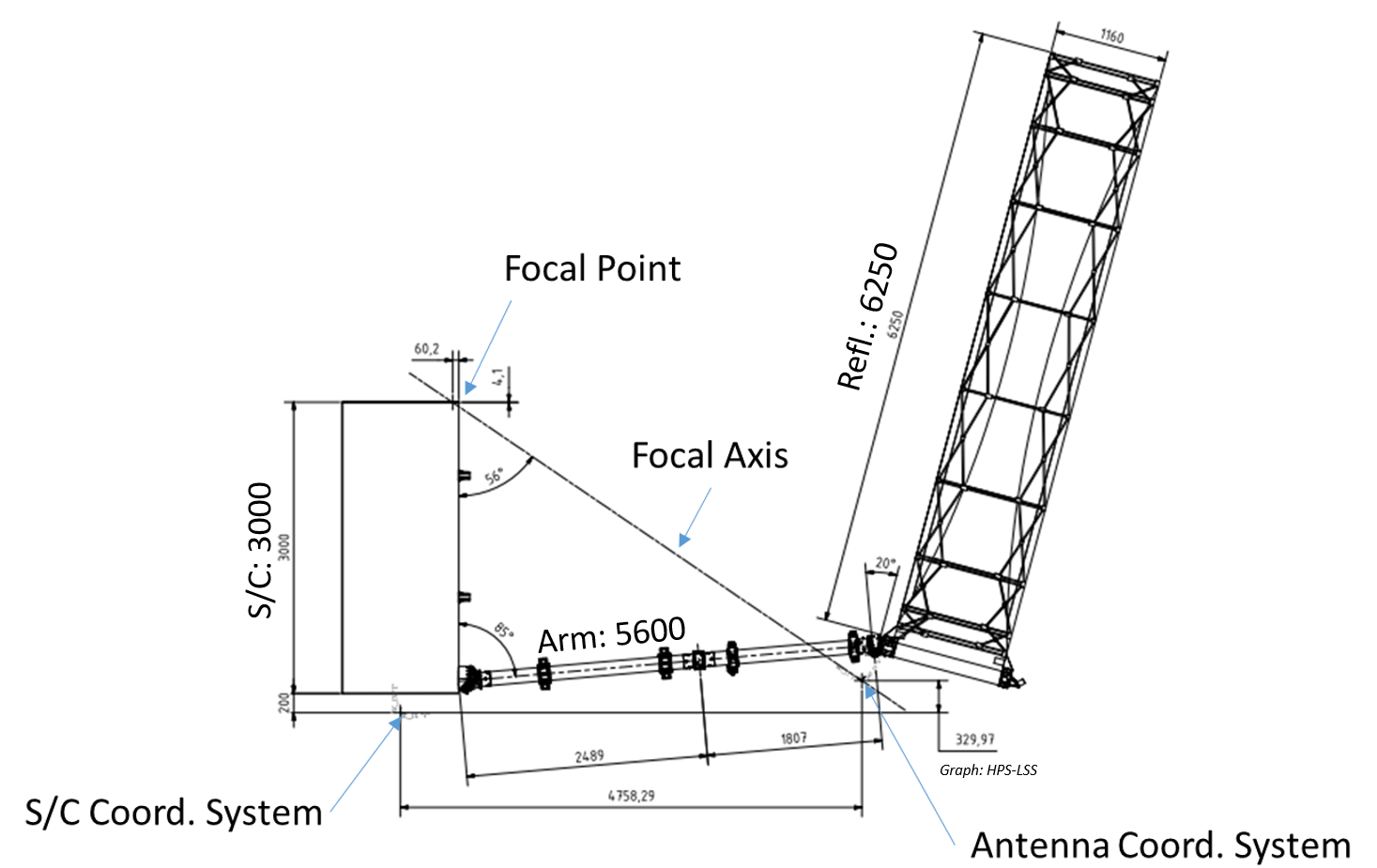
Description:
- Development project under the European H2020 Program (sector „non-dependence“)
- Space application: Earth Observation, Telecom, Military
- Objective:
- Realization of a Protoflight-Model (“LEA-X5 PFM”)
- Complete Large Deployable Reflector Subsystem
- 5m aperture diameter for X-band applications
- Large test campaign (deployment, surface accuracy, thermal, vibration, RF)
- PFM is offered for free to potential satellite programs in exchange to flight opportunity
- Budget: 5 Mio Euro grant by European Commission + 2 Mio Euro team’s investment
- Timeframe: 11/2017 – 02/2021
- Start TRL: 5, End TRL: 8
- Ready to launch: Q2/2021
References:
Team (“WeLEA”):
- 16 development partners (DE, PT, ES, DK, SE)
- Lead: HPS-Germany (implementation & technical management)
- Main contribution: LSS (deployable reflector assembly)
- Further consortium partners: FHP, RUAG, TICRA, vH&S, INVENT, HPTEX, LUMA, ETAMAX, INEGI, INTA, AIRBUS, OHB, TAS, WSS.
Features:
- LEA-X5 PFM includes: reflector, deployment mechanisms, metal mesh, arm, hinges, hold-down-and-release-mechanisms, thermal hardware, harness, deployment control electronics, deployment test-MGSE & -EGSE, RF test-GSE.
- LEA-X5 PFM specification:
- 5.1 m reflective aperture diameter
- 6.15 m ring diameter (max.)
- 5.65 m arm length
- F/D = 1.0
- X-band (10.65 GHz) for structure and in-orbit performance
- Ku-band (18.7 GHz) for RF-compatibility tests
- Subsystem total onboard mass: 110.3 kg
- Deployed total mass: 98 kg.
- LEA-products are scalable:
- 3 m to 25 m reflector diameter
- 1 m to 20 m arm lenght
- RF frequencies: C-, L-, S-, P-, Ku-, Ka-Band.
Highlights:
- 02.11.2017: Kick-off
- 18.01.2018: Major LEA-X5 PFM parameters specified.
- 20.07.2018: Preliminary Design Review
- 11.04.2019: Critical Design Review
- Sept. 2020 (tbc): Test Readiness Review
- Oct. 2020 (tbc): Completion of RF test
Entfaltbares Armkonzept (ABDS)
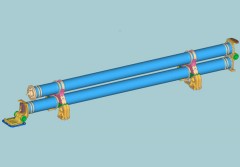
Description:
- Development project under ESA’s Technology Research Program
- Subject: Deployable arm assembly (DAA) for large deployable reflector subsystems (LDRS), comprising of
- Ultra-stable deployable CFRP boom segments
- Highly reliable deployment hinges
- Fixed at hold-down-and-release mechanisms.
Remark: Derivates feasible for heavy scientific instruments to be deployed.
- Objectives:
- Development of a two-segment 6m deployable arm Engineering Model (EM)
- Test campaign (functional deployment, thermo-elastic distortion, vibration, deployment under thermal vacuum)
- Team:
- Prime Contractor to ESA: HPS Germany
- Subcontractors: RUAG (DE), INVENT (DE), DLR (DE), INEGI (PT), VTT (FI), OHB (DE)
- Budget: 1.1 Mio Euro
- Timeframe: 07/2016 – 12/2018
- End-TRL: 5-6 (depending on application)
Special thanks to
- Julian Santiago Prowald and Alexander Ihle (Technical Officers at ESA), who are for us one of the initiators of the “European Solution of LDRS” and who contributed significantly to the technical progress.
Features:
- Modular and scalable extending up to 30 m length
- Pointing accuracy: 0,1 mm per m
- Stowed Eigenfrequency: > 130 Hz
- Deployed Eigenfrequency: > 1 Hz
- Mass: 8 kg/m
Reflektives Metallnetz (MESNET)
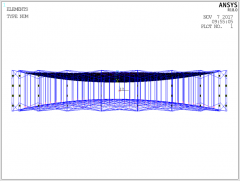
Description:
- Development Project ESA`s ARTES Program
- Objectives:
- Development of a Ku-band metal mesh for LDRS for telecom-applications
- Development of an highly accurate carrying network
- Extensive trade-off and selection of raw materials and processes
- Performance of extensive characterization tests
- Realisation of a 5m Engineering Model of a reflective surface
- Traceable step-by-step procedures for final assembly of mesh, network, and integration onto a reflector ring.
- Surface accuracy and thermo-elastic distortion test campaign
- Team:
- HPS Germany (prime contractor and mesh development)
- HPS Romania (subcontractor for carrying network manufacturing process development and EM assembly),
- Budget: 600 kEuro in contract to ESA plus 400 kEuro investment by HPS-DE, HPS-RO and further development partners.
- Timeframe: 04/2016 – 12/2020
- End TRL: 5-6
Special thanks to
- Jean Christophe Angevain (Technical Officer at ESA), who is for us one of the most important promoters of the “European Solution of LDRS” and who contributes significantly to all our mesh developments.
Features for Engineering Model:
- 5 m ring diameter
- C-band to Ku-band frequency
- Mesh type: ATLAS knitting pattern, 18 OPI, gold plated tungsten wire
- Supporting network with triangle size of 250mm.
Highlights:
- 19.04.2016: Kick-off
- 16.11.2017: HRR
- 17.09.2019: MRR
- Q3/2020 (tbc): TRR
- 12/2020 (tbc): Delivery and contract close-out
Entfaltbares Reflektorkonzept (SCALABLE)
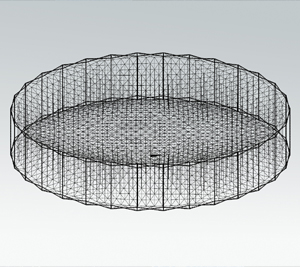
Description:
- Development project under ESA’s Technology Research Program
- Objectives:
- Development of a large deployable reflector concept, which is highly scalable and compliant for Earth observation as well as for telecommunication missions
- Extensive trade-off and selection of reflector architecture and deployable concept
- Testing of most critical items on breadboard level
- Realization of a 5m Engineering Model (EM) for C-band applications
- Start of metal mesh development
- Functional deployment and accuracy test campaign.
- Team: HPS Germany (prime contractor), LSS (subcontractor for reflector)
- Budget: 970 kEuro in contract to ESA
- Timeframe: 12/2012 – 12/2016
- End-TRL: 4-5 (depending on application)
Special thanks to
- Julian Santiago Prowald (Technical Officer at ESA), who is for us one of the initiators of the “European Solution of LDRS” and who contributed significantly to the creation of the reflector architecture.
- Leri Datashvili (CEO and Chief Designer of LSS), who is for us one of the most important fathers of large deployable reflectors (LDR) in Europe.
- Prof. Horst Baier (former lead of the Chair of Lightweight Structures at the Technical University of Munich), who enabled for many years research & education on and several pre-developments of LDRs at the University.
Features:
- Modular and scalable between 5 m and 20 m diameter (EM: 5m)
- Scalable up to Ka-Band (application for EM: C-Band, L-Band, S-Band)
- Target mass of reflector assembly: 25 kg (5 m) and 60 kg (12 m)
- LEO application for Earth Observation
- GEO application for Telecommunication
- Selected architecture: “double shifted pantograph“
(remark: this was the basis for all later LEA-products)
References:
- Live deployment at ESA/ESTEC on 23.11.2016; © ESA

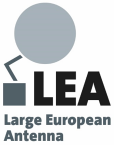
 LEA-X5 & European 5m X-band LDRS Completed
LEA-X5 & European 5m X-band LDRS Completed